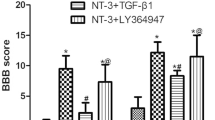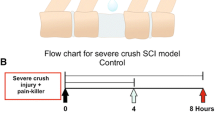Abstract
In recent years, various studies have been conducted toward the goal of achieving regeneration of the central nervous system using neural stem cells. However, various complex factors are involved in the regulation of neural stem cell differentiation, and many unresolved questions remain. It has been reported that after spinal cord injury, the intrinsic neural stem cells do not differentiate into neurons but, rather, into astrocytes, resulting in the formation of glial scars. Based on reports that the expression of interleukin (IL)-6 and the IL-6 receptor (IL-6R) is sharply increased in the acute stages after spinal cord injury and that IL-6 may serve as a factor strongly inducing the differentiation of neural stem cells into astrocytes, we examined the effects of an antibody to IL-6R in cases of spinal cord injury and found that the antibody suppressed secondary injury (caused by inflammatory reactions) and glial scar formation, facilitating functional recovery. This article presents the data from this investigation and discusses the relationship between IL-6 signals and spinal cord injury.
Similar content being viewed by others
References
Hugenholtz, H. (2003), JCMA 168, 1145,1146.
Reynolds, B. A., Tetzlaff, W., and Weiss, S. (1992), J. Neurosci. 12, 4565–4574.
Okano, H. (2002), J. Neurosci. Res. 69, 698–707.
Johansson, C. B., Momma, S., Clarke, D. L., et al. (1999), Cell 96, 25–34.
Bradbury, E. J., Moon, L. D., Popat, R. J., et al. (2002), Nature 416, 636–640.
Nakamura, M., Houghtling, R. A., MacArthur, L., Bayer, B. M., and Bregman, B. S. (2003), Exp. Neurol. 184, 313–325.
Taga, T. and Kishimoto, T. (1997), Annu. Rev. Immunol. 15, 797–819.
Okada, S., Nakamura, M., Mikami, Y., et al. (2004), J. Neurosci. Res. 76, 265–276.
Bonni, A., Sun, Y., Nadal-Vicens, M., et al. (1997), Science 278, 477–483.
Klein, M. A., Moller, J. C., Jones, L. L., et al. (1997), Glia 19, 227–233.
Brunello, A. G., Weissenberger, J., Kappeler, A., et al. (2000), Am. J. Pathol. 157, 1485–1493.
Lacroix, S., Chang, L., Rose-John, S., and Tuszynski, M. H. (2002), J. Comp. Neurol. 454, 213–228.
Ma, M., Basso, D. M., Walters, P., Stokes, B. T., and Jakeman, L. B. (2001), Exp. Neurol. 169, 239–254.
Dumont, A. S., Dumont, R. J., and Oskouian, R. J. (2002), Curr. Opin. Neurol. 15, 713–720.
Popovich, P. G. and Jones, T. B. (2003), Trends Pharmacol. Sci. 24, 13–17.
Choy, E. H., Isenberg, D. A., Garrood, T., et al. (2002), Arthr. Rheum. 46, 3143–3150.
Marz, P., Cheng, J. G., Gadient, R. A., et al. (1998), Proc. Natl. Acad. Sci. U. S. A. 95, 3251–3256.
Loddick, S. A., Turnbull, A. V., and Rothwell, N. J. (1998), J. Cereb. Blood Flow Metab. 18, 176–179.
Okano, H., Ogawa, Y., Nakamura, M., et al. (2003), Semin. Cell Dev. Biol. 14, 191–198.
Author information
Authors and Affiliations
Corresponding author
Rights and permissions
About this article
Cite this article
Nakamura, M., Okada, S., Toyama, Y. et al. Role of IL-6 in spinal cord injury in a mouse model. Clinic Rev Allerg Immunol 28, 197–203 (2005). https://doi.org/10.1385/CRIAI:28:3:197
Issue Date:
DOI: https://doi.org/10.1385/CRIAI:28:3:197




